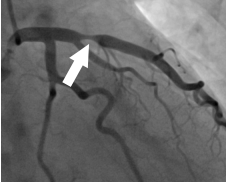Coronary angiography and Percutaneous Coronary Intervention (PCI)
Where a narrowing is identified in a coronary artery during a coronary angiogram, the cardiologist may treat the lesion using a stent (fine mesh tube). This is known as Percutaneous Coronary Intervention (PCI).
Narrowings are treated with balloons and stents that reduce the chance of renarrowing.
Before and After Stenting


The first image shows a narrowing in the left anterior descending coronary artery which supplies blood to the left side of the heart. The second image shows the disease area treated with a stent (mesh tube) restoring the blood supply to the heart.
Coronary angiograms and Percutaneous Coronary Intervention (PCI) will be carried out in an angiography suite (“catheter lab”) at Intra Epsom or Intra North Harbour. Your cardiologist will be assisted by a team of professional nurses and highly skilled medical personnel.